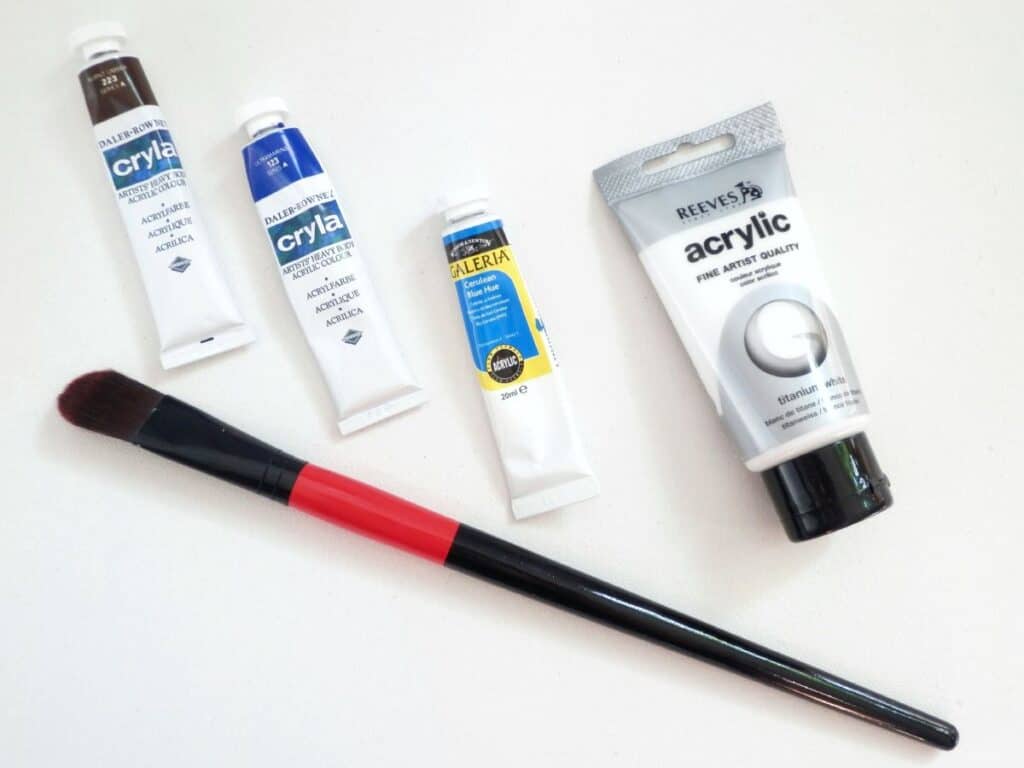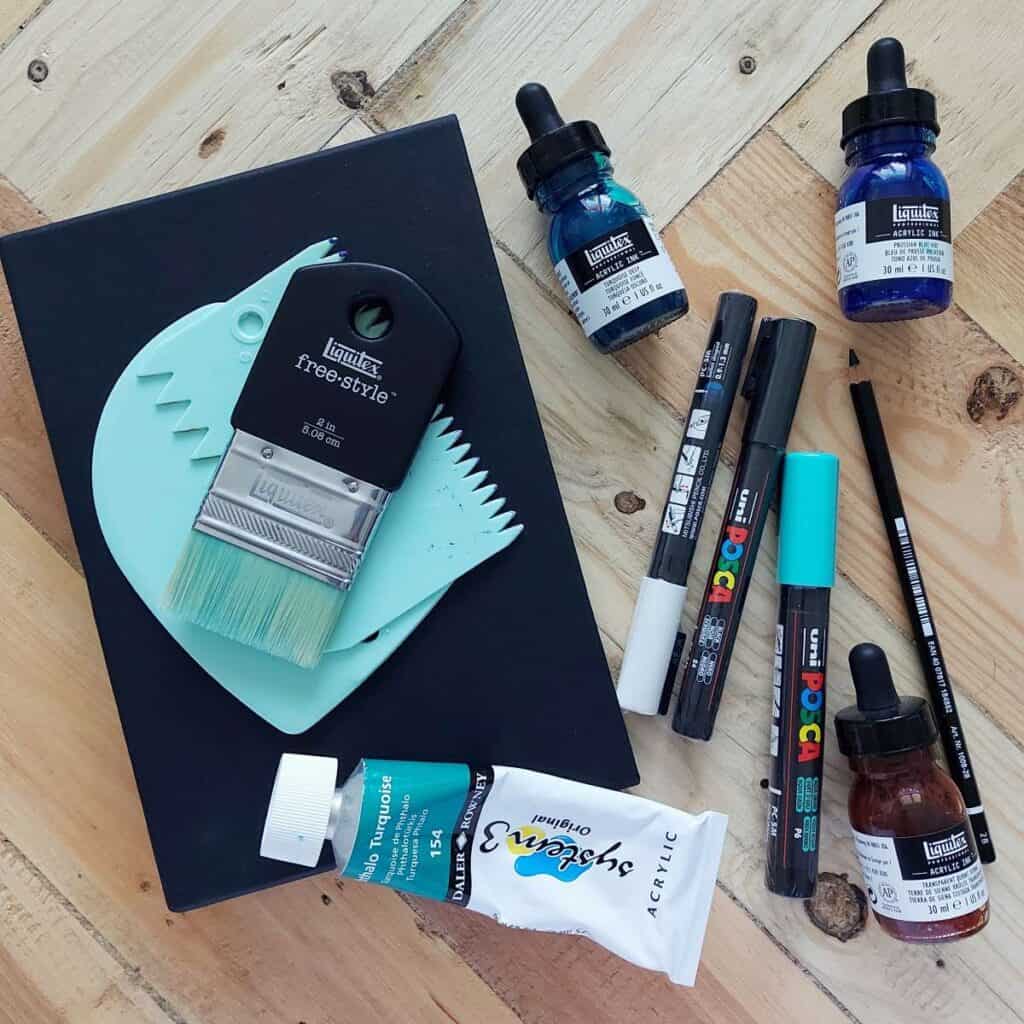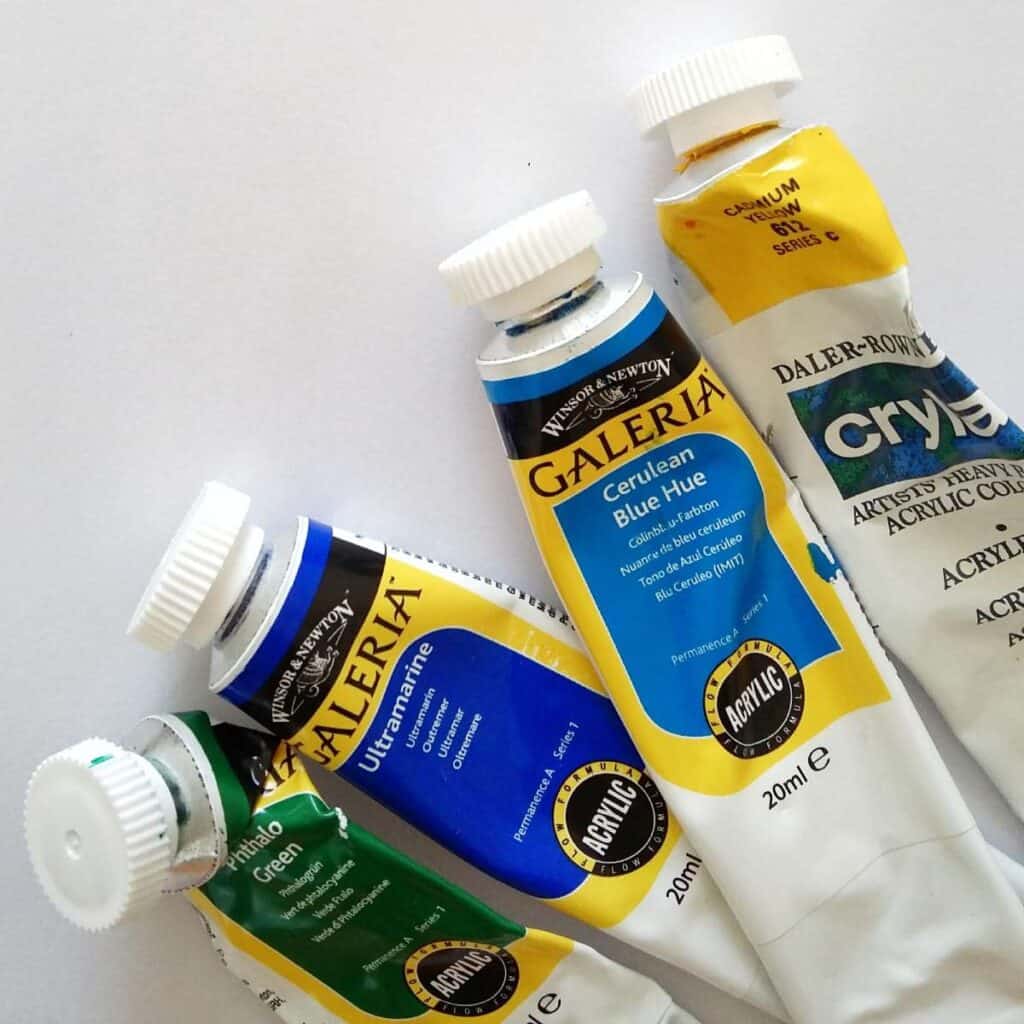If you’re just starting out with acrylic painting and you’re confused about the difference between heavy body, soft body and fluid paints, let me help you out. Read on to find out more about the types of acrylic paint and when you might use them.
But first things first — if you’re really new to acrylic painting, you might like to check out my glossary of acrylic painting terms and 7 things beginners need to know about acrylic painting.
Then when you’re done, come back here for a more in-depth look at the different types of acrylic paint available.
Sign up for my monthly emails of creative tips, tutorials and DIYs and get 31 free creative prompts!

You can unsubscribe at any time
Types of acrylic paint
I’m going to cover the four main types of acrylic paint people commonly use a brush or palette knife to paint with. There are also things like acrylic markers and acrylic spray paints which I won’t be covering.
1. Heavy body acrylic paint
Heavy body acrylic paint has the thickest texture and is spreadable like soft butter. It can be thinned with water or an acrylic medium, making it very versatile.
(It’s worth bearing in mind that thinning heavy body paint will make it more transparent. So if you want a thinner consistency but need opaque, saturated colour, you might be better off buying one of the other types of acrylic paint mentioned below.)
If you want a lot of texture in your paintings, heavy body is the way to go. It retains brush strokes very well, so a lot of atmosphere can be conveyed in the way the paint is applied to the canvas.
If you like painting with palette knives or this is something you want to try in the future, try heavy body paint. The paint can be applied thickly, like oil paint, as another way to achieve a lot of texture.
It’s also possible to create more texture by using tools or your paintbrush handle to make marks in the wet paint.

2. Soft body acrylic paint
Soft body paint has a softer texture than heavy body. While heavy body paint is like butter, soft body paint is comparable to yogurt. It holds some texture, but not as much as heavy body.
Soft body paint can be a little easier to use straight from the tub than heavy body, as it spreads across the surface more easily. It also makes it easier to paint on a rough surface.
There can be some confusion between soft body paint and the next type of paint, fluid paint. This is because manufacturers don’t all use the terms soft body and fluid paint to describe the same thing. If you’re in any doubt when buying paint from different brands, it’s always best to check!
3. Fluid acrylic paint
Fluid acrylics are looser again in texture. They tend to level out on the painting surface, meaning they don’t hold brush strokes or texture. If texture isn’t something you want or need in your paintings, fluid acrylics are the way to go.
Fluid acrylics are great for covering large areas, and they’re also great for flicking, dripping or splattering. I also know of abstract artists that use fluid acrylics to create colours, shapes and layers in their paintings without building texture.
If you find yourself constantly thinning your paint, try fluid acrylics.
4. Acrylic inks
Like you might expect given the name, acrylic inks are a kind of very fluid, highly pigmented acrylic.
You can use them for some really interesting effects, similar to those you can achieve with watercolours but with very vivid colour. Like fluid acrylics, acrylic inks are also great for layering, flicking, dripping and splattering.
Acrylic inks also dry waterproof, as other kinds of acrylics do, so you can’t reactivate them once they’re dry. And they can be used straight out of the bottle for lettering and sketching.
I love painting with acrylic inks and have painted many paintings I LOVE using this wonderful medium!

Acrylic paint quality
So now you know about the different types of acrylic paint available, you’ll also need to know about the range of different paint qualities and brands.
1. Craft paint
This is the cheapest kind of acrylic paint and contains the least pigment. It’s available in a huge range of colours, which is great since craft paints often don’t mix very well to create other colours.
Craft paints usually offer poor coverage so they often don’t layer very well. For this reason, it might be best to opt for better quality paint if you like to work in layers. Otherwise you could well find yourself frustrated and needing to paint multiple layers of the same colour.
2. Student grade paint
These paints are ideal for experimenting with as a hobbyist. Although they contain less pigment than artist grade paints, you can still achieve good colour mixes and make great paintings.
I personally find student grade paint a great happy medium. This is because they offer good coverage and feel good to paint with, but they aren’t so expensive that I’m scared to use them generously when I need or want to!
3. Artist or professional grade paint
Professional or artist grade paint is the best quality paint with the highest amount of pigment.
Consequently it’s the most expensive kind of paint. Saying that, you’ll probably find you need to use a lot less than with one of the cheaper paints as the coverage is so much better.

You get what you pay for with acrylic paint
Well known acrylic paint brands include Winsor & Newton, Daler Rowney, Liquitex, and Golden. But are they worth paying for when generic brands are available too?
Anyone who’s painted for a while will probably have their favourite acrylic paint brand. But I think most people would agree that as a general rule, you get what you pay for with acrylic paints.
A lot of the time, the actual pigment that gives the paint its colour is expensive, and that drives the price of the better quality paints up.
Generally, the cheaper the paint, the less pigment it contains. This can mean cheaper paints don’t cover as well, and you can end up using more paint overall.
I made this mistake once when I ran out of titanium white and needed to get some pretty quickly. I went to the nearest stationery store and bought a generic brand, and it wasn’t long before I really wished I hadn’t.
When I used it, I had to use twice as much as my previous brand, and I also had to use multiple coats. I actually used it much more quickly than the previous tube, so it was definitely a false economy. I’m now happily using a branded tube again and back to the experience I’m used to!
When you shouldn’t buy expensive paint
So for the best user experience, buy the best quality paint available within your budget. But there’s no point buying expensive paint if you can’t really afford it, as you won’t enjoy painting with it.
There’s also no point buying expensive paint if you think you might be afraid to use it liberally. Yes, it’s called artist or professional grade paint, but that doesn’t mean you have to be a professional artist to use it!
Sometimes cheaper paint can actually be more freeing, as you’re not scared to slap it on. (Technical term right there 😂)
So if you want to experiment, sometimes cheaper paint is the way to go. This is especially true if you’re trying a new technique and you’re not sure it’ll work how you hope it will.
Otherwise, I’d say buy the best quality paint you can comfortably afford — but ONLY if you’ll use it!
Now I’d love to hear from you. Leave a comment below to let me know what your favourite type of acrylic paint is and why.
I’d also love to know if there’s anything you feel I missed out or anything that doesn’t make sense!
About Stacey

I’m Stacey and I’m a blogger, abstract artist and freelance writer. My aim is to help busy people feel inspired and get more creative with tutorials, hints and tips.
I live in Cardiff with my partner and dog, and in my free time you’ll find me hiking, reading, painting or sampling a craft beer or two.

